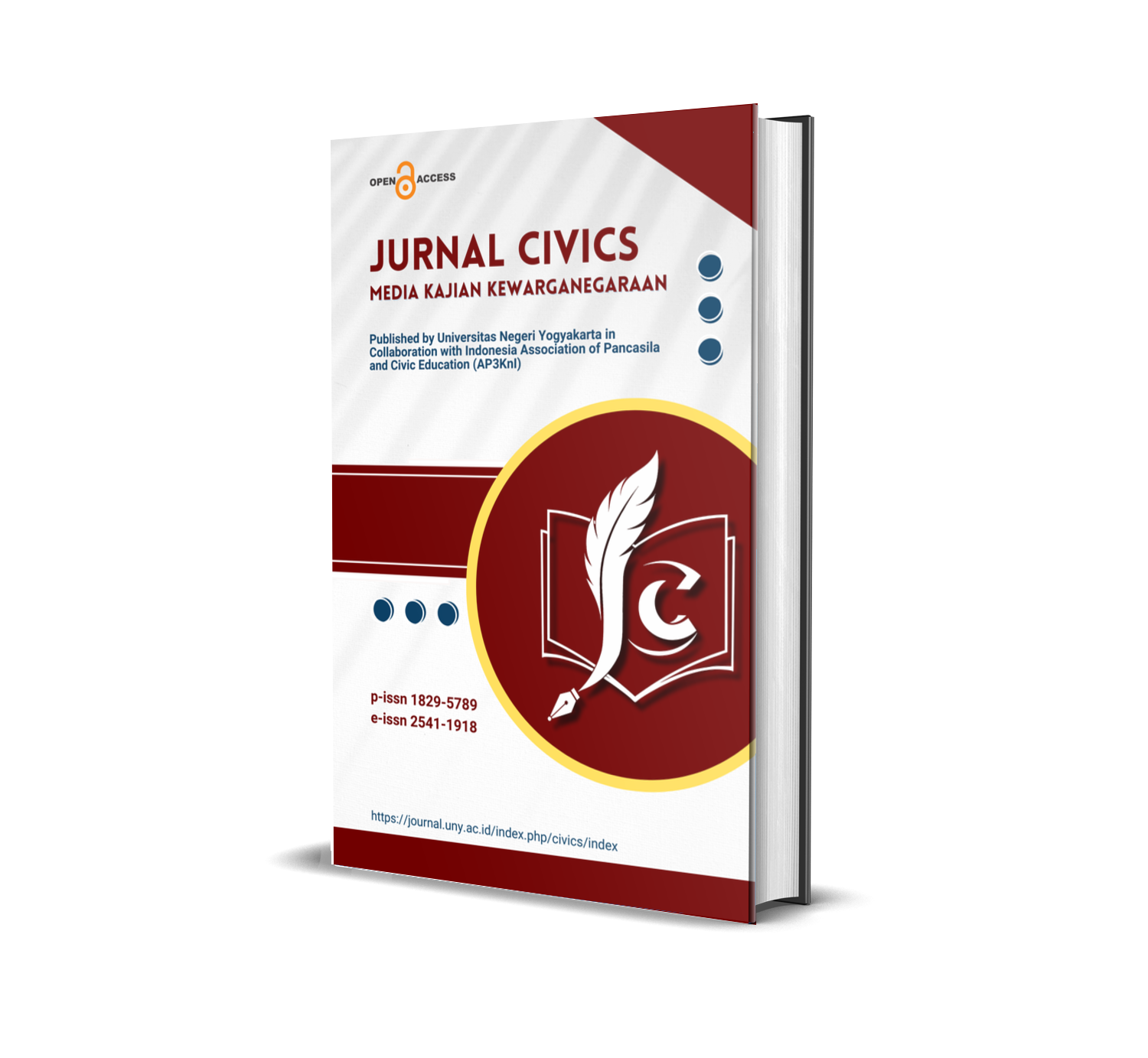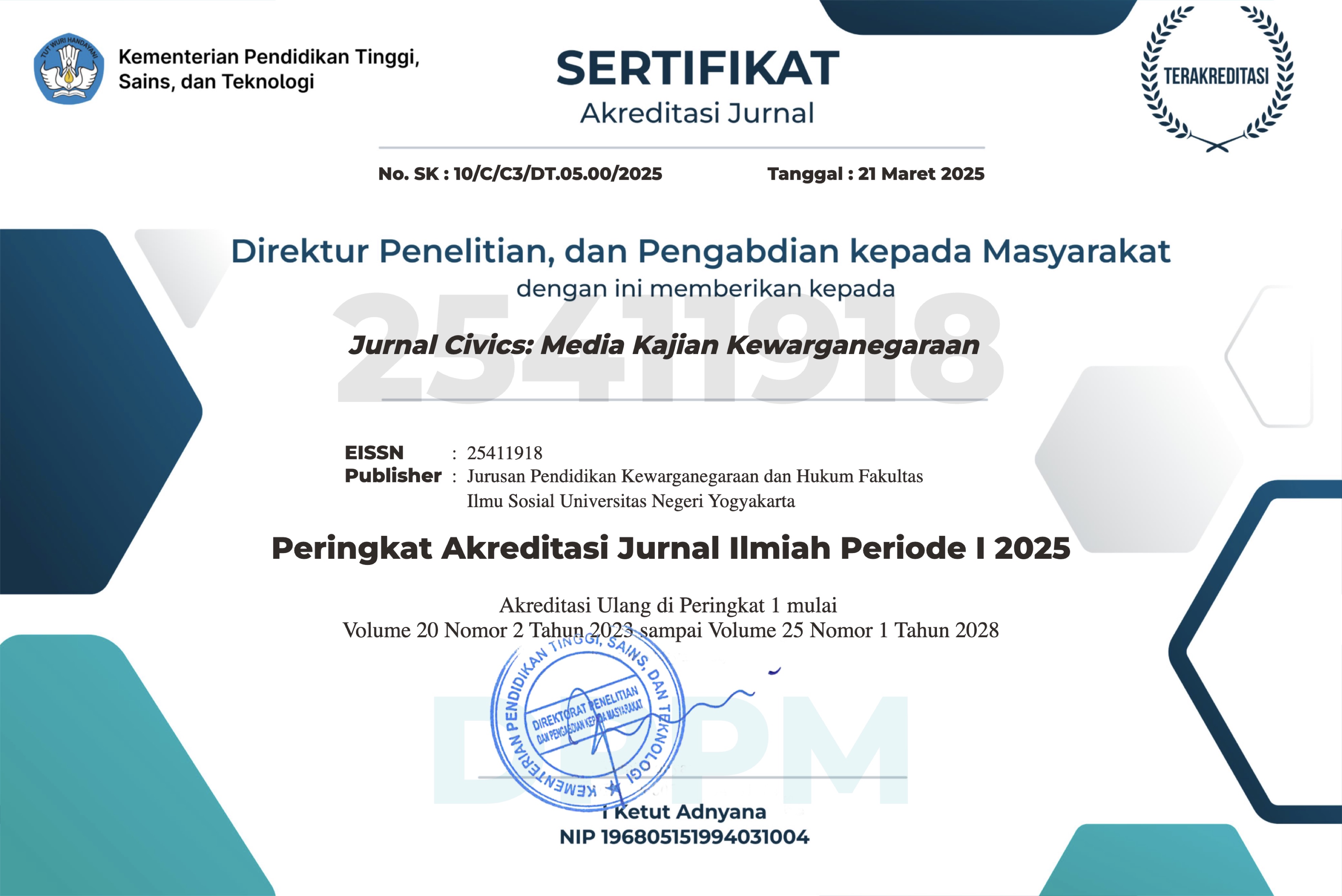Promoting Pancasila ideology through comic based learning media
DOI:
https://doi.org/10.21831/jc.v21i2.56665Keywords:
ADDIE, illustrated storybook media, learning outcomes, Pancasila and Civic Education (PCE), PPKn, R & D.Abstract
This research's objectives are to 1) develop a storybook with a picture (comic) as a learning media for Pancasila and Civic Education (PCE) and 2) to evaluate its effectiveness in improving the learning results of grade V elementary school students in learning the values of Pancasila. This is research and development by implementing the ADDIE model, which consists of five stages: analysis, design, development, implementation, and evaluation. The research's subjects are 27 students of V (A), 28 students of V (B) and eight students of V (C) as experiment, control, and limited test classes, respectively. The result of the development found that the product, a book with pictures, is suitable for learning after being evaluated by a media expert and a material expert with evaluations of 99 and 71, respectively. The effectivity evaluation was conducted using a t-test on the experiment and control classes with sig. value of 0.000<0.005. The post-test results from the experiment and control classes are 70.64 and 60.93, respectively, which shows that the experiment class had higher mean results than the control class. The research concluded that the storybook with pictures is effective and suitable for enhancing the students' learning achievement.
References
Alfaqi, M. Z. (2016). Melihat sejarah nasionalisme Indonesia untuk memupuk sikap kebangsaan generasi muda. Jurnal Civics: Media Kajian Kewarganegaraan, 13(2), 209–216. https://doi.org/10.21831/civics.v13i2.12745
Amir, H. (2019). Metode penelitian dan pengembangan research & development. Litersi Nusantara.
Anggraeni, L., Darmawan, C., Tanshzil, S. W., & Jubaedah, E. (2021). Promoting ksatria bela negara comic through the webtoon for the prevention and control Covid-19. Jurnal Civics: Media Kajian Kewarganegaraan, 18(1), 138–147. https://doi.org/10.21831/jc.v18i1.39377
Apostolou, D., & Linardatos, G. (2023). Cognitive load approach to digital comics creation: a student-centered learning case. Applied Sciences, 13(13), 7896. https://doi.org/10.3390/app13137896
Arsyad, A. (2014). Media Pembelajaran. rev. ed. Raja Grafindo Persada.
Bahrudin, F. A. (2019). Implementasi kompetensi mata kuliah pendidikan kewarganegaraan di perguruan tinggi dalam menghadapi tantangan globalisasi. Pro Patria: Jurnal Pendidikan, Kewarganegaraan, Hukum, Sosial, dan Politik, 2(2), 184–200. https://doi.org/10.47080/propatria.v2i2.593
Berkowitz, J., & Packer, T. (2001). Heroes in the classroom: comic books in art education. Art Education, 54(6), 12–18. https://doi.org/10.1080/00043125.2001.11653471
Cahaya, F., Andini, I. S., Bangun, M. Br., Damanik, R. M., Batubara, S. N., & Maisaroh, S. (2023). Use of big book learning media in improving the reading ability of class VII students at SMPN 1 Tanjung Pura. International Journal of Educational Practice and Policy, 1(2), 48–54. https://doi.org/10.61220/ijepp.v1i2.0238
Callow, J. (2020). Visual and verbal intersections in picture books – multimodal assessment for middle years students. Language and Education, 34(2), 115–134. https://doi.org/10.1080/09500782.2019.1689996
Eilam, B., & Poyas, Y. (2010). External visual representations in science learning: The case of relations among system components. International Journal of Science Education, 32(17), 2335–2366. https://doi.org/10.1080/09500690903503096
Epley, N., Waytz, A., & Cacioppo, J. T. (2007). On seeing human: A three-factor theory of anthropomorphism. Psychological Review, 114(4), 864–886. https://doi.org/10.1037/0033-295X.114.4.864
Farinella, M. (2018). The potential of comics in science communication. Journal of Science Communication, 17(1). https://doi.org/10.22323/2.17010401
Faruk-Islim, O., Ozudogru, G., & Sevim-Cirak, N. (2018). The use of digital storytelling in elementary Math teachers’ education. Educational Media International, 55(2), 107-122. https://doi.org/10.1080/09523987.2018.1484045
Gerlach, V. S., Ely, D. P., & Melnick, R. (1971). Teaching and media: A systematic approach. Prentice-Hall
Hansson, L., Leden, L., & Thulin, S. (2020). Book talks as an approach to nature of science teaching in early childhood education. International Journal of Science Education, 42(12), 2095-2111. https://doi.org/10.1080/09500693.2020.1812011
Hosler, J., & Boomer, K. B. (2011). Are comic books an effective way to engage nonmajors in learning and appreciating science?. CBE Life Sciences Education, 10, 309–317. https://doi.org/10.1187/cbe.10-07-0090
Hsieh, F. P., Chen, Y. A., Wu, H. J., & Tsai, C. Y. (2023). Promoting first graders’ scientific thinking through picture books with the 5E model. The Journal of Educational Research, 116(3), 147-158. https://doi.org/10.1080/00220671.2023.2219635
Ikhbal, M., & Musril, H. A. (2020). Perancangan media pembelajaran fisika berbasis android. Information Management for Educators And Profesional, 5(1), 15. https://doi.org/10.51211/imbi.v5i1.1411
Jee, B. D., & Anggoro, F. K. (2012). Comic cognition: exploring the potential cognitive impacts of science comics. Journal of Cognitive Education and Psychology, 11(2), 196–208. https://doi.org/10.1891/1945-8959.11.2.196
Junioviona, A. Q., Setyowati, N., & Yani, M. T. (2020). Pengembangan komik sebagai media pembelajaran untuk meningkatkan hasil belajar siswa materi sikap yang mencerminkan sila-sila Pancasila Kelas III Sekolah Dasar. Jurnal Education and Development Institut, 8(3), 95–100.
Kaelan. (2014). Pendidikan Pancasila (10th ed.). Paradigma.
Kerneža, M., & Košir, K. (2016). Comics as a literary-didactic method and their use for reducing gender differences in reading literacy at the primary level of education. Center for Educational Policy Studies Journal, 6(2), 125–149. https://doi.org/https://doi.org/10.26529/cepsj.91
Kibtiyah, M. A., Utaminingsih, S., & Surachmi, S. (2023). Development of digital comic based on flipbook for students of fifth-grade elementary school in Pati district. ICCCM Journal of Sosial, 2(6), 21–27. https://doi.org/https://doi.org/10.53797/icccmjssh.v2i6.4.2023
Kusumaningsih, D., Rahmawati, S., & Nurweni, A. (2024). Peningkatan hasil belajar PPKn model NHT dengan media lapbook Di SD Muhammadiyah Trayu. Elementary School, 11(1), 301–307. https://doi.org/10.31316/esjurnal.v11i1.4273
Liu, J. (2004). Effects of comic strips on L2 learners’ reading comprehension. TESOL Quarterly, 38(2), 225–243. https://doi.org/10.2307/3588379
Mahnun, N. (2012). Media pembelajaran (Kajian terhadap langkah-langkah pemilihan media dan implementasinya dalam pembelajaran). Jurnal Pemikiran Islam, 37(1), 27–33. https://ejournal.uin-suska.ac.id/index.php/Anida/article/view/310
Mantzicopoulos, P., & Patrick, H. (2011). Reading picture books and learning science: engaging young children with informational text. Theory Into Practice, 50(4), 269–276. https://doi.org/10.1080/00405841.2011.607372
Nasution. (2013). Berbagai pendekatan dalam prose belajar mengajar. Bumi Aksara.
Nurgiansah, T. H. (2021). Pendidikan Pancasila sebagai upaya membentuk karakter jujur. Jurnal Pendidikan Kewarganegaraan Undiksha, 9(1), 33-41. https://ejournal.undiksha.ac.id/index.php/JJPP/article/view/31424
Nurgiyantoro, B. (2018). Teori pengkajian fiksi. UGM press.
Nurrita, T. (2018). Pengembangan media pembelajaran untuk meningkatkan hasil belajar siswa. MISYKAT: Jurnal Ilmu-Ilmu Al-Quran, Hadist, Syari’ah Dan Tarbiyah, 3 (171). https://doi.org/10.33511/misykat.v3n1.171
Pakpahan, E. I. S., & Sinaga, B. (2023). The application of comic-based learning assisted by Pixton to improve mathematical creative thinking skill of Class IX SMPN 8 Percut Sei Tuan. Asian Journal of Applied Education (AJAE), 2(3), 471–480. https://doi.org/10.55927/ajae.v2i3.5004
Puspitorini, A. (2019). Analisis nilai-nilai karakter dan nilai nilai Matematika melalui permainan tradisional Madura pada siswa SD. Reflektika, 14(2), 127–150. https://doi.org/10.28944/reflektika.v14i2.1029
Rahman, A., & Madiong, B. (2017). Pendidikan kewarganegaraan di perguruan tinggi. Celebes Media Perkasa.
Rahmawati, A. (2016). Penerapan SQ3R berbantunan reka cerita gambar untuk meningkatkan pemahaman membaca dan hasil belajar siswa. Profesi Pendidikan Dasar, 3(2), 127–133. https://journals.ums.ac.id/index.php/ppd/article/view/3827/0
Rambe, R., & Putri, R. T. (2024). Crossword puzzle learning media to improve indonesian vocabulary mastery. Jurnal Ilmiah Sekolah Dasar, 7(4), 762–768. https://doi.org/https://doi.org/10.23887/jisd.v7i4.61292
Römer, L., Supa, M., & HodboÄ, V. (2023). Media literacy education nurturing civic participation of disadvantaged youth, or not?. Learning, Media and Technology, 48(3), 372-386. https://doi.org/10.1080/17439884.2022.2051046
Rutta, C. B., Schiavo, G., Zancanaro, M., & Rubegni, E. (2021). Comic-based digital storytelling for content and language integrated learning. Educational Media International, 58(1), 21-36. https://doi.org/10.1080/09523987.2021.1908499
Saga, H. (1993). Students’ perceptions of media and teachers as related to the depth of their learning. Educational Media International, 30(3), 158–167. https://doi.org/10.1080/0952398930300309
Saidurrahman, H., & Arifinsyah, H. (2018). Pendidikan kewarganegaraan: NKRI harga mati. Kencana.
Samsuri, S. (2021). Pendidikan karakter warga negara: Kritik pembangunan karakter bangsa. Pustaka Hanif.
Sanjaya, W. (2014). Media komunikasi pembelajaran (1st ed.). Kencana.
Sari, & Lestari. (2018). Pengaruh media pembelajaran visual terhadap hasil belajar ekonomi siswa. Jurnal Neraca: Jurnal Pendidikan dan Ilmu Ekonomi Akuntansi, 2(2), 71–80. https://doi.org/https://doi.org/10.31851/neraca.v2i2.2690
Sintayani, N. K., Wibawa, I. M. C., & Antara, P. A. (2023). Papan pintar acak kata for improves reading skills of grade ii elementary school students. Jurnal Ilmiah Sekolah Dasar, 7(4).
Spiegel, A. N., McQuillan, J., Halpin, P., Matuk, C., & Diamond, J. (2013). Engaging teenagers with science through comics. Research in Science Education, 43(6), 2309–2326. https://doi.org/10.1007/s11165-013-9358-x
Suganda, Setiawan, & Ma’ruf. (2022). Pengembangan media komik untuk meningkatkan hasil belajar siswa kelas IV SD. Jurnal Pendidikan Dewantara: Media Komunikasi, Kreasi dan Inovasi Ilmiah Pendidikan, 8(1), 8–15. https://doi.org/https://doi.org/10.55933/jpd.v8i1.187
Sugiyono. (2017). Metode penelitian dan pengembangan untuk bidang pendidikan, manajemen, sosial, teknik: Research and development (3rd ed.). Alfabeta.
Sulastri, S., Syahril, S., Adi, N., & Ermita, E. (2022). Penguatan pendidikan karakter melalui profil pelajar pancasila bagi guru di sekolah dasar. JRTI (Jurnal Riset Tindakan Indonesia), 7(3), 583. https://doi.org/10.29210/30032075000
Sunarti, & Rahmawati, S. (2013). Penilaian dalam Kurikulum 2013. Andi Offset.
Sunarti, S., Rahmawati, S., & Wardani, S. (2016). Pengembangan game petualangan “si bolang” sebagai media pembelajaran tematik untuk meningkatkan motivasi dan prestasi belajar siswa kelas v sekolah dasar. Cakrawala Pendidikan, 1, 58–68. https://doi.org/10.21831/cp.v1i1.8365
Sunarti, S., Rahmawati, S., & Wardani, S. (2017). Development of animation-based fairy tales learning model for elementary school students. Proceeding International Conference on Science and Engineering, 239–243.
Susanto, A. (2013). Teori belajar dan pembelajaran di sekolah dasar. Jakarta: Kencana
Toh, T. L., Cheng, L. P., Ho, S. Y., Jiang, H., & Lim, K. M. (2017). Use of comics to enhance students’ learning for the development of the twenty-first century competencies in the mathematics classroom. Asia Pacific Journal of Education, 37(4), 437-452. https://doi.org/10.1080/02188791.2017.1339344
Wallner, L. (2020). Kid friendly? constructions of comics literacy in the classroom. Language and Literature, 29(1), 76–94. https://doi.org/10.1177/0963947020910626
Williams, R. M. C. (2008). Image, text, and story: comics and graphic novels in the classroom. Art Education, 61(6), 13-19. https://doi.org/10.1080/00043125.2008.11652072
Downloads
Published
How to Cite
Issue
Section
Citation Check
License
The authors agree to transfer the transfer copyright of the article to The Jurnal Civics: Media Kajian Kewarganegaraan effective if and when the paper is accepted for publication.
Authors and other parties are bound to the Creative Commons Attribution-NonCommercial-ShareAlike 4.0 International License for the published articles, legal formal aspect of journal publication accessibility refers to Creative Commons Attribution-NonCommercial-ShareAlike 4.0 International License (CC BY-NC-SA).










